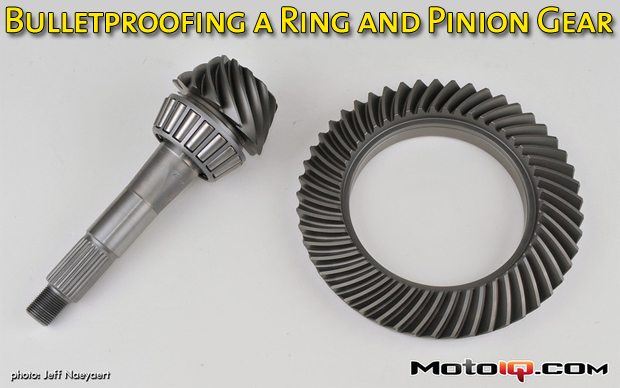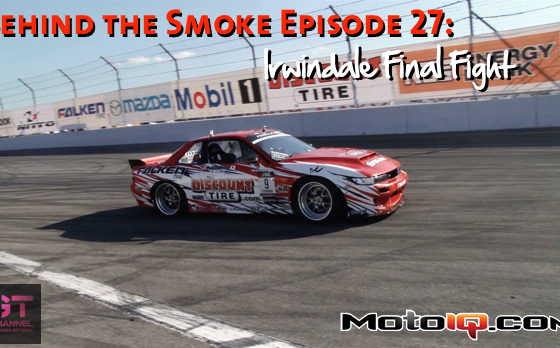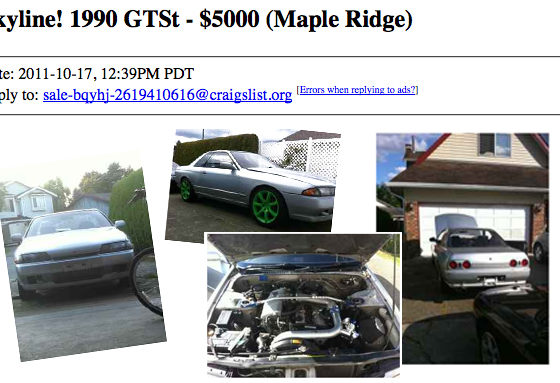,
 Walker against Otto Graven's LS-7 powered 350Z.
Walker against Otto Graven's LS-7 powered 350Z.Cryo treating does several things to improve the strength of ferrous alloys. Cryo treating first stress relieves the metal, neutralizing the internal stress of the part caused by forging the gear blank and the machining operation. This in itself makes the part more fatigue resistant and dimensionally stable. Most importantly, cryo treating converts austenite (a softer phase of steel crystalline structure) within the steel of the gears to the harder crystalline structure martensite. This improves the metal's mechanical properties. Cryogenic treatment generally can improve the fatigue strength and wear resistance of steel gears by over 100%. Cryo treatment is relatively inexpensive, usually a ring and pinion cost less than $40 to process.
 A used ring and pinion as we got it from Walker. Ideally a new part should be used that hasn't been fatigued yet but this part came off of a junkyard stock car and had never seen the stress of competition in a high powered car so we figured it would be OK.
A used ring and pinion as we got it from Walker. Ideally a new part should be used that hasn't been fatigued yet but this part came off of a junkyard stock car and had never seen the stress of competition in a high powered car so we figured it would be OK.After cryogenic treatment we sent the gear out to a local aerospace job shop to be shotpeened. Shotpeening is the bombardment of the surface of the steel with hard steel shot at high velocities. This refines the grain of the surface of the metal to a depth of around 2-3 thousandths of an inch and imparts a compressive stress on the surface. This creates a skin on the surface of the part in which cracks have a hard time developing. Shotpeening can improve the fatigue strength of a steel part over 100%.
 The back side of the ring gear. The black look to the gear is caused by Nitriding, a surface hardness treatment used by the factory to improve wear resistance. Nitriding leaves a super hard surface so we would have to take extra care in our treatment.
The back side of the ring gear. The black look to the gear is caused by Nitriding, a surface hardness treatment used by the factory to improve wear resistance. Nitriding leaves a super hard surface so we would have to take extra care in our treatment.The stock ring and pinion gears are nitrided, a process that leaves a hard, wear resistant skin on the surface of the gear. Because of the hard nitrided skin and the complex geometry of the ring and pinion itself, we used a special two step process intended for hardened steel. The gears were hit hard with special hardened steel shot of R65 hardness intended for hard materials at an almen intensity of .025 or higher. This is typically the maximum velocity capability of most shotpeening machines.
 After cryo treatment the gear looks the same. After inspecting the pinion bearing and determining that it was in excellent shape, we decided to leave it on and let it get treated as well. In the case of the R200, the pinion fails in the teeth. Other gears might fail under the pinion head. In that case it would be a good idea to remove the bearing and treat that area to shotpeening and WPC as well.
After cryo treatment the gear looks the same. After inspecting the pinion bearing and determining that it was in excellent shape, we decided to leave it on and let it get treated as well. In the case of the R200, the pinion fails in the teeth. Other gears might fail under the pinion head. In that case it would be a good idea to remove the bearing and treat that area to shotpeening and WPC as well.A two step shotpeening process should be used for gears. First, the ring gear and pinion head and shaft must be hit hard with a large 330 size shot. This really helps establish a compressed layer on the tooth faces and tops. Then the gears and shaft should be blasted again with smaller 220 shot. This gets into the roots of the gear teeth and the base of the pinon shaft splines. Shotpeening is also relatively inexpensive; the two step process mentioned here usually costs under $50.
 When shotpeening the pinion we instructed the shotpeeners to mask off the bearing so the roller retainers would not be damaged. We also had them mask the bearing area at the rear of the shaft so it would not be distorted by the aggressive shot treatment regimen we had prescribed.
When shotpeening the pinion we instructed the shotpeeners to mask off the bearing so the roller retainers would not be damaged. We also had them mask the bearing area at the rear of the shaft so it would not be distorted by the aggressive shot treatment regimen we had prescribed.


